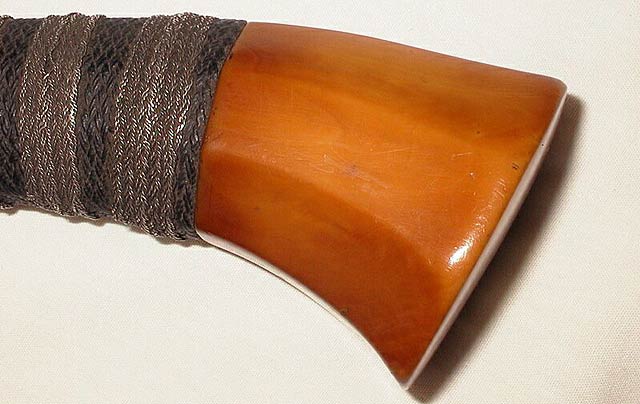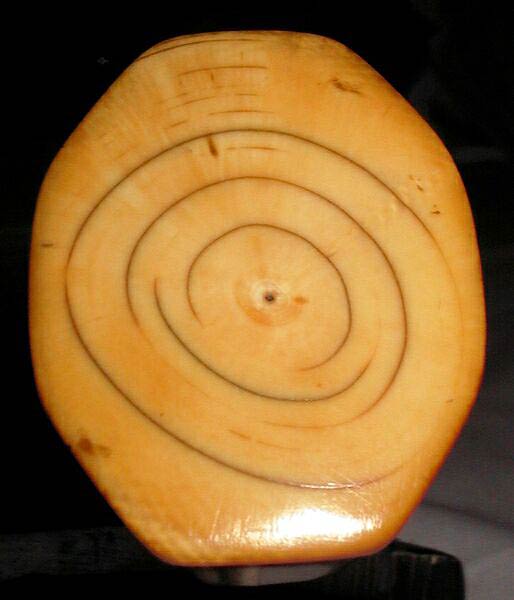
 |
|
|
|
|
#1 |
|
EAAF Staff
Join Date: Dec 2004
Location: Louisville, KY
Posts: 7,280
|
Pinoy,
W  W! Thank you for showing this example - georgios kris. W! Thank you for showing this example - georgios kris. Rick, I think you have a good point. I was wondering this myself for the same reasons, and it was not unheard of to use hippo ivory. This might explain some of why this pommel is not larger than it is (elephant being larger tusk). |
|
|

|
|
|
#2 |
|
Vikingsword Staff
Join Date: Dec 2004
Location: The Aussie Bush
Posts: 4,399
|
Pinoy:
Lovely color to the ivory -- rich golden, with a slight reddish hue. Could this be dugong ivory? There is an example in Cato that he calls Sea cow (dugong),* and some time ago we had a discussion about dugong ivory on the old forum. Ian. Robert Cato. Moro Swords. Graham Bush Ltd: Singapore, 1996, Figure 42, p. 69 Last edited by Ian; 22nd April 2006 at 04:27 AM. |
|
|

|
|
|
#3 | |
|
Member
Join Date: Jan 2006
Posts: 50
|
Quote:
I had mine polished, but didn't change a thing. I thought ivory as it gets older they turn to light golden/yellow, like the aged pool cue balls, this ones are just dark orange. Tea stained? Last edited by panday; 22nd April 2006 at 04:54 AM. |
|
|
|

|
|
|
#4 |
|
Vikingsword Staff
Join Date: Dec 2004
Location: The Aussie Bush
Posts: 4,399
|
The depth of color seems to vary a lot, but in general I think ivory gets darker with age and handling. I have several old ivory-hilted dha from Burma and Thailand that have ivory that is quite dark, almost as though it has been smoked.
I think that body oils (grease) get transferred during handling and carrying and this is mainly responsible for the color change. Add a little dirt (as seen in the fine cracks) and we end up with the familiar look of old ivory. Dugong (sea cow, manatee) ivory has a distinct reddish hue to it. I've now seen several illustrated examples and I believe that I own a kris with dugong ivory (at least it was sold to me as dugong ivory by a Filipino dealer in Manila whom I have dealt with for many years, and it matches the color of the dugong hilt in Cato). Ian. Here are pictures of that hilt.  
|
|
|

|
|
|
#5 |
|
Member
Join Date: Jan 2006
Posts: 50
|
Dugong (sea cow, manatee) ivory has a distinct reddish hue to it. I've now seen several illustrated examples and I believe that I own a kris with dugong ivory (at least it was sold to me as dugong ivory by a Filipino dealer in Manila whom I have dealt with for many years, and it matches the color of the dugong hilt in Cato).
Stellar sea cow/manatee/dugong raw material. |
|
|

|
|
|
#6 | |
|
Vikingsword Staff
Join Date: Nov 2004
Posts: 6,339
|
Quote:
 Panday , that Sea Cow ivory looks very porous in cross section . Interesting ..... Rick |
|
|
|

|
|
|
#7 |
|
Member
Join Date: Dec 2004
Posts: 1,018
|
Punal, good catch on that Kris. Congrats.
I believe the Seacow Ivory are the ribs that's why it's so porous. I have seen them for sale at Knife shows. |
|
|

|
|
|
#8 | |
|
Vikingsword Staff
Join Date: Nov 2004
Posts: 6,339
|
Quote:
So this would then be fossil material ? |
|
|
|

|
|
|
#9 |
|
Member
Join Date: Jan 2006
Posts: 50
|
I believe the Seacow Ivory are the ribs that's why it's so porous. I have seen them for sale at Knife shows.[/QUOTE]
Kino, You are absolutely right, this are sea cow ribs and most were fossilized, the ones that I have, are not(Stellar peices). I have contacted several sellers and asked them if there was really a sea cow ivory and all of them gave the same answer! sea cow bone, is ivory, sea cow tusk? Question, the sea cow ivory on Cato's book, is that a bone or tusk? Last edited by panday; 22nd April 2006 at 11:42 PM. |
|
|

|
|
|
#10 | |
|
Vikingsword Staff
Join Date: Dec 2004
Location: The Aussie Bush
Posts: 4,399
|
Rick:
I think this may be an artefact of how I manipulated the image in Photoshop. Sometimes using the "sharpen" tool can create distortion and bring out patterns that aren't really there. The cross hatching is not visible in the original image. The concentric rings and central vein suggest that this example is a tusk (tooth) rather than a rib. Ian. Quote:
|
|
|
|

|
 |
|
|